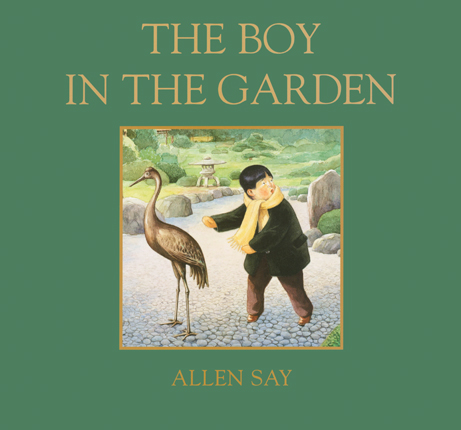Full Text Reviews: School Library Journal - 10/01/2010 Gr 2–5—Say takes the ancient legend about a crane magically transformed into a woman through an act of kindness and adds another layer of mystery to the story. A brief retelling of "the Grateful Crane," as told to Jiro by his mother, sets the scene. The rest of the book traces the child and his father's visit to Mr. Ozu, who has a "famous garden and many treasures in his house." Intrigued by the life-size bronze crane, Jiro investigates first the statue and then a small seemingly empty cottage on the property. When a tall, lovely Japanese lady appears, he finds himself playing out the tale. Is she the crane personified? Is he the woodcutter from the story? With the arrival of his father to take him home, he is left to ponder: Was this just a dream? The care and subtlety the artist employs to make the contemporary twist believable, in both text and illustration, is extraordinary. A final magnificent image depicts a crane flying through the night sky beneath a full moon. Carefully chosen words mesh seamlessly with dramatic and effective paintings, bringing both energy and tranquility to carry the story to its thought-provoking ending.—Barbara Elleman, Eric Carle Museum of Picture Book Art, Amherst, MA - Copyright 2010 Publishers Weekly, Library Journal and/or School Library Journal used with permission. Booklist - 09/01/2010 Say’s book begins with a brief retelling of the Japanese folktale “The Grateful Crane,” in which a woodcutter frees a crane and later marries a mysterious woman. The woman weaves fabric that enriches the couple until her husband sees her at work, at which time she reverts to being a bird. In Say’s quixotic story, a boy and his father visit a rich man, Mr. Ozu. Young Jiro wanders the grounds and finds a statue of a crane. Remembering the tale, he thinks it’s real. His father and Mr. Ozu laugh, and the boy is humiliated. Then a mysterious cottage beckons, a beautiful woman appears, and so begins the boy’s own reenactment of “The Grateful Crane.” Although the mood is evocative in the manner of fairy tales, there’s a question here of audience. Jiro looks to be about six, yet the issues the book raises—about the illusion of story and the nature of reality—would probably be best contemplated by an older child. Still, Say’s artwork, with its clean, quiet scenes, always pleases, and the more perceptive child will take much away from this. - Copyright 2010 Booklist. Bulletin for the Center... - 11/01/2010 Bored on an adult-imposed trip to a famous garden, Jiro wanders off; still steeped in his mother’s retelling of “The Grateful Crane,” he first mistakes a crane statue in the garden for a live bird, and then stumbles upon a small cottage that seems to be the very house from the folktale. There Jiro encounters a beautiful woman, seemingly the enchanted crane of the story, and he strives to shift his iteration of the tale away from its usual sad ending. The “it was all a dream-or was it?” conclusion is a bit of a cliché, but Jiro’s encounter with traditional story is otherwise multilayered and compelling. Say quietly draws on Jiro’s feelings of exclusion from the adult world and on his separation from his mother (who initially read him the tale), poignantly demonstrating the boy’s yearning for grownup competence and for a combined Oedipal and narrative triumph, whereby he could both care for the motherly woman better than her husband did and make the story come out the way he wishes. Say’s watercolors have a smooth, even control that’s perfect for his realistic portraiture, with far-reaching landscapes emphasizing Jiro’s isolation, but that mode also manages to shade seamlessly into an airy, slightly stylized folkloric style in the crane wife herself and in her household with Jiro; the first view up the curving path of stones to the little cottage is a silent evocation of embarkation into the world of legend. Not only does this offer an unusual entrée into a folklore discussion, it provides an excellent opportunity to share Bodkin’s haunting Crane Wife (BCCB 10/98). A brief retelling of “The Grateful Crane” opens the book. DS - Copyright 2010 The Board of Trustees of the University of Illinois. Loading...
|



